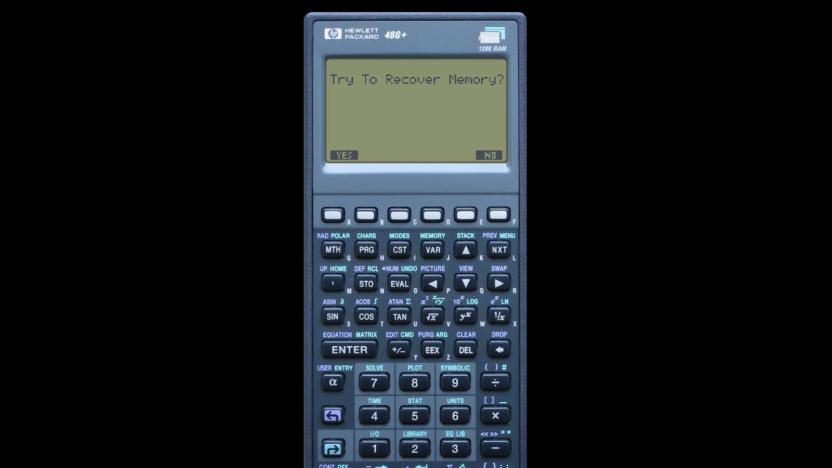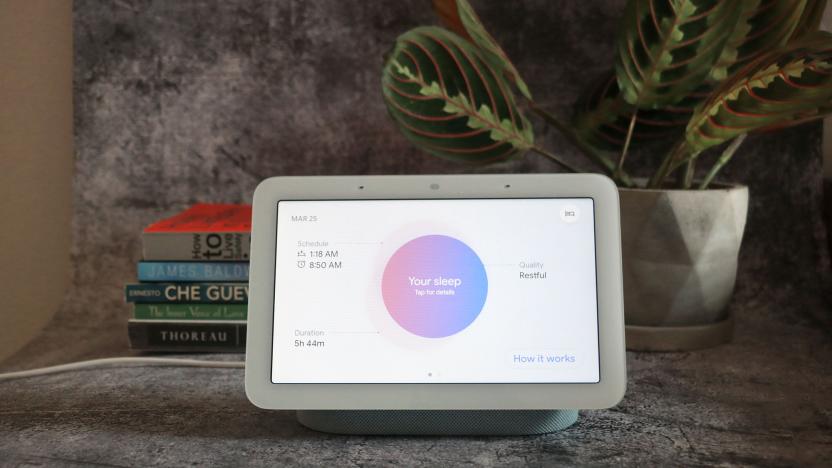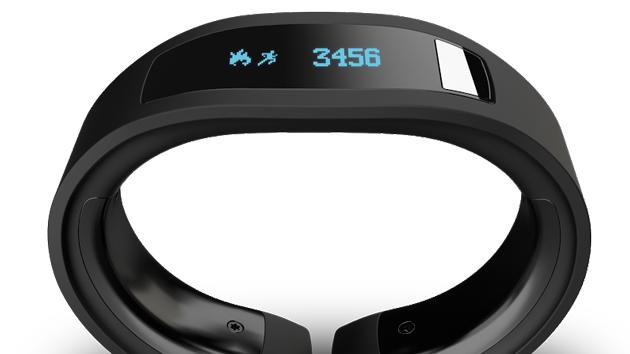Texas Instruments
Latest

The Internet Archive's Calculator Drawer lets you relive high school math class
You can now use the Internet Archive to emulate old handheld calculators.

Google and Ford want to bring small radar to more devices
Google and Ford are partners in a new standard that could bring radar to more devices for touch-free control and health tracking.

Texas Instruments makes it harder to run programs on its calculators
Texas Instruments has pulled the support for assembly-based programs on its graphing calculators -- it's meant to fight cheating, but also hurts hobbyists.

Moore's Law in action: making our machines ever more micro
Over the past few decades, engineers have leveraged Moore's Law to the fullest, resulting in powerful ultrathin laptops and feature-rich miniature wearables. Back in 1981, a 23-pound Osborne 1 computer was considered portable, with 64KB of onboard memory. Today, smartphones weigh just a few ounces and easily pack 128GB of storage. There's also a vastly more complex architecture of circuits and sensors inside these devices, all at a scale nearly invisible to the eye. It's taken us decades to develop and shrink down these microelectronics to where they are today, which is no small feat. Join us as we ride the ever-shrinking gadget wave from its early days to some of the nanoscopic creations at work today.

A 56-year-old prototype of the first microchip going up for auction
Without the integrated circuit (IC) basically none of the things you take for granted in your life would exist. And it's not just your smartphone, tablet or laptop. Your TV, microwave even your car is loaded with microchips. Auction house Christie's will be selling-off an early prototype of the integrated circuit built by Jack Kilby in 1958 while he was working at Texas Instruments. That was the year that he, along with Robert Noyce, first demonstrated a functioning IC which combines multiple electronic functions on a single slab. Most often that is silicon, but in the late 50s Kilby turned to germanium. Now you have a chance own a piece of computer history, which Kilby and his team eventually one a Nobel Prize for in 2000. Of course, you'll need to come up with the estimated $1 to $2 million the chip is expected to fetch at Thursday's auction.

G-Series wearable tracks sports, sleep and sitting
The language on Movea's site can be a bit broad and tough to parse at times when trying to figure out exactly what the company produces. The simple answer is motion tracking, particularly as it pertains to things like sports and physical therapy. It makes sense, then, that the company was eager to jump on the activity-tracking wearable bandwagon, celebrating CES by teaming up with Texas Instruments for the G-Series. The wristband monitors a pretty broad spectrum of activities and, well, non-activities, counting your steps, tracking running/hiking, analyzing sleep activity and even detecting your posture (whether you're, say, sitting or standing). The wearable promises a greater than 95 percent accuracy rate when it comes to activity classification and the lowest error rates when it comes to counting steps. Maybe we'll try it out -- we've got a few more steps to walk around the Las Vegas Convention Center this week.

Texas Instruments brings fast charging, extended life to Li-ion batteries
Yesterday Texas Instruments introduced a couple of new chipsets (fuel gauge an charger ICs) designed to improve the charging speed and life expectancy of single-cell Li-ion batteries. The technology, called MaxLife, is expected to provide an improvement of up to 30 percent in battery service life and faster charging times. Cell impedance is carefully monitored by the fuel gauge chip while the charger IC uses a model of battery degradation to charge the cell in the most effective way. Both chips are connected via an I2C bus to form an autonomous battery management system which, according to the company, is safer and more thermally efficient than existing solutions. The two chipsets (2.5A and 4.5A) are now available along with a development kit, so it's only a matter of time until this technology lands into handsets and other devices that use single-cell Li-ion batteries. Check out the details after the break.

TI shows off LaunchPad-based prototype mouse, hints at a big follow-up
If you've been needing a little inspiration for your next TI LaunchPad project, look no further than the company itself. Texas Instruments set up shop in the maker tent across from the Austin Convention Center this week, showing off creations built atop its line of microcontrollers. The rep we spoke with was particularly excited about this mouse hack that the company put together in a few hours, while getting ready for SXSW. The creation utilizes the Stellaris board's accelerometers to control the cursor of a Windows machine on X, Y and Z axes, via USB. The project is more than just a hack, according to the company -- it's actually a prototype of something it's set to unveil later this year. No specifics on that front, but TI promised a "big surprise." In the meantime, you can check out video of the project after the break.%Gallery-181193%

Apple opens third Israeli development center
Globes is reporting that Apple has now opened its third R&D center in Israel. The facility is based in the city of Ra'anana and will be staffed by 100 to 150 former Texas Instruments employees that were laid off late last year and earlier this year. Perviously it was reported Apple only hired "dozens" of those workers. The Ra'anana R&D center comes after Apple acquired flash memory maker Anobit for up to US$500 million in December 2011 and opened a Haifa-based R&D center in 2012. As with the previous two R&D centers, no one knows exactly what Apple is working on at Ra'anana. Globes states that when TI owned the facility its operations were primarily based on "technological capabilities in short-range communication chips, mainly for WiFi, Bluetooth and NFC" but that "in all likelihood Apple will take the Ra'anana center into a different strategic direction."

Live from the Engadget CES Stage: an interview with Texas Instruments' Frank Moizio (update: video embedded)
Love tiny projectors? Boy have we got the conversation for you! We'll be speaking with Texas Instruments business manager, DLP Pico Projection, Frank Moizio, who will be showing off new devices featuring the technology and discussing the company's new architecture and the outlook for pico projectors in the future. January 9, 2013 12:30 PM EST Check out our full CES 2013 stage schedule here! Update: video embedded

TI to be driving force behind Audi's next-gen MIB High infotainment platform
The race to claim the "best infotainment system in a luxury ride" title is, we'd say, still pretty wide open, however that's not to say we haven't seen our fair share of neat ones in the recent past. Still, it's worth noting that Texas Instruments and Audi have announced a partnership which will see the chipset maker's new Jacinto 5 processor command the German outfit's next-generation, QNX-powered infotainment system, more formally known as MIB High. For Audi, this means taking a slightly different route, as it had previously utilized the likes of NVIDIA's Tegra 3 on its platform, but it also doesn't surprise us given TI's promise of "stunning digital audio" and "feature-rich vehicle interfaces" thanks to its "multimedia applications unit and a highly integrated radio and car control unit." Update: NVIDIA's reached out to us to clarify that its tech will indeed still be featured inside Audi's future infotainment systems -- you'll find the company's official statement down below. NVIDIA is and will continue to be the heart and soul of the award winning infotainment system found in the newest Audis and VWs, and soon other brands in the VW Group. For the MIB infotainment system, Audi uses a variety of technologies, the key one being the Multimedia Applications Unit (MMX), which is designed and produced by NVIDIA. The modular design enables Audi to easily migrate from Tegra 2, to Tegra 3 and beyond, bridging the gap that traditionally existed between consumer electronics and automotive systems. Another element of the Audi system is the Radio and Car Control Unit (RCC). NVIDIA's Tegra processor powers the MMX, while Texas Instrument's processors are used in the RCC.

Apple hiring former Texas Instruments chip designers for Israeli R&D center
Texas Instruments' loss is looking to be Apple's gain. In its efforts to shrink its global workforce by some 1,700 jobs, TI recently let go 250 of its employees in Israel previously tasked with designing chips for mobile devices. According to The Next Web, Apple has snapped up "dozens" of them to staff its R&D facilities in Hertezliya and Haifa, Israel. The new hires were previously working on TI's OMAP (Open Multimedia Applications Platform) hardware and wireless chips used for WiFi and Bluetooth purposes. At Apple the new hires will work under the auspices of the recently formed Technologies group, which is overseen by Bob Mansfield. It's the component of Apple that will be responsible for semiconductor design going forward and is comprised of the folks responsible for silicon including the A6 and A6X used in the iPhone 5 and fourth-generation iPad, respectively.

TI details the wireless power chip in the Lumia 920, offers four times the charging area
If you're one of the first on your block to have picked up a Nokia Lumia 920, you might wonder why it's so forgiving with where you set it down on the wireless charging pad. TI is more than willing to share. The 920, 820, Fatboy charging pillow and JBL PowerUp speaker all use a new TI bq500410A controller whose support for new transmitters gives it a charging area four times larger than we're used to. The 2.76 by 0.79 inches of coverage might not sound like much, but it's much wider than the previous 0.71 square inches while preserving a 70 percent efficiency and a safety cutoff if something gets in between. As a companion, there's a bq51050B chip launching at the same time that represents the first Qi receiver with its own built-in battery charger, which TI claims can charge more quickly and in less space than its rivals. Anyone embracing Nokia's vision of Windows Phone 8 can get their hands on devices using the wireless power chips today; we're only left hoping that TI's official news means other phone makers can tag along.

Motorola Solutions outs HC1 head-mounted computer, keeps workers' hands free in sticky situations (update: video)
We're very familiar with Kopin's Golden-i, but it was surprising that an early collaboration with Motorola Solutions didn't immediately lead to Motorola selling the head-mounted computer on its own. That odd discrepancy is being patched up now that Motorola Solutions' HC1 is here. The design keeps its signature micro-display, head tracking and voice commands, but sees a slight repurposing from Kopin's focus on security: Motorola Solutions' attention is on giving construction workers, field technicians and soldiers an always-up computer that keeps their hands free when it would be too dangerous (or just unwieldy) to grab a handheld. We haven't been told if the HC1 has been upgraded to that promised TI OMAP 4 chip, although we do know that there's an optional camera to bring on the Aliens-style video feeds as well as pairing support that offers cellular data, GPS and voice calls when linked to the right phone or hotspot. Whether or not the HC1 keeps the Golden-i's $2,500 price is an unknown as well -- that said, the corporate emphasis is more likely to see bulk sales of the wearable PC than any kind of scrimping and saving. Update: You'll find an official clip for the HC1 after the break. The clip also confirms that there's no OMAP 4 in this version.

Amazon eyeing up TI's smartphone chip business, according to Israeli newspaper
Remember when Texas Instruments revealed it was planning to dump its mobile processor business in favor of embedded systems? Israeli business sheet Calcalist is reporting that Amazon is in "advanced negotiations" to snap up that part of TI's OMAP division, which currently supplies processors for the Kindle Fire and the Nook HD. The paper suggests the company is emulating Apple's purchases of chip designers in order to lower the price of future hardware -- which it currently sells at cost.

Texas Instruments wants to ditch smartphones, switch focus to embedded processors
Texas Instruments has made the startling announcement that it's going to wind down its wildly successful smartphone and tablet business in favor of embedded systems. VP Greg Delagi told investors that the switch would create a more "stable" and "long-term business" than the cutthroat battles it's faced in mobile. While, currently the world's third biggest semiconductor company, it's concerned about losing ground to players like Qualcomm, Samsung and Apple -- despite its latest OMAP CPUs powering tablets like the Nook HD and Kindle Fire. We're scratching our heads as to why a major player would drop such a strong position like this, but perhaps they know something that we don't.

Linux Foundation forms Automotive Grade Workgroup, aims to open-source your ride with Tizen
It doesn't take much driving to notice that many in-car infotainment systems are custom-built and locked down tight. The Linux Foundation sees it differently and wants our cars to embrace the same notions of common roots and open code that we'd find in an Ubuntu box. Its newly-formed Automotive Grade Linux Workgroup is transforming Tizen into a reference platform that car designers can use for the center stack, or even the instrument cluster. The promise is to both optimize a Linux variant for cars and provide the same kind of years-long support that we'd expect for the drivetrain. Technology heavy-hitters like Intel, Harman, NVIDIA, Samsung and TI form the core of the group, although there are already automakers who've signaled their intentions: Jaguar Land Rover, Nissan and Toyota are all part of the initial membership. We don't know how soon we'll be booting into Tizen on the morning commute, but we'd expect in-car systems to take a step forward -- just as long as we don't have to recompile our car's OS kernel.

Amazon Kindle Fire HD torn down, proves an easy fix
Interested in what makes your new Kindle Fire HD 7-inch tick? The crew at iFixit certainly is. As is the repair shop's custom, it just tore down Amazon's new reader tablet to gauge its repairability as well as look for any surprises. In the case of the revamped Kindle Fire, the fixable design is the main surprise -- despite being skinnier than its ancestor, the tablet is easy to open and its components (usually) easy to replace. We're not as shocked by the choice of hardware makers, which include an LG Display LCD, the expected 1.2GHz TI OMAP 4460 processor and Samsung flash memory. Head on over to the source if you'd like to see the nitty gritty of Amazon's Android slab and possibly save the trouble of a replacement unit down the road.

ViewSonic VSD220 Smart Display with Android 4.0 comes to US in October, dips to $399
You might remember ViewSonic's slightly strange VCD22 Smart Display from our journey to Computex. If the sight of that 22-inch, Android-based all-in-one desktop set your heart aflutter, you'll be glad to know the finished version is coming to the US as the VSD220 by mid-to-late October. It's decidedly less portable what we saw in Taipei this June and strips out the battery we suspect most buyers wouldn't have used. For better or worse, though, most everything else is the same: while we didn't expect a change to the TI OMAP 4 processor, the VSD220 will be clinging to Android 4.0 instead of upgrading to Android 4.1 for its trip across the Pacific. The micro-HDMI video input, 1.2-megapixel front camera, microSD slot, three USB ports and Ethernet (yes, Ethernet) do help justify a space on the desk, especially for those who want a secondary display for another mobile device or PC. The VSD220 faces a stiff fight from traditional all-in-ones that don't always cost much more -- but we'll at least get a price drop to a more palatable $399 in return for our patience.

BeagleBone gets plenty of expansion options with new 'cape' add-ons
Arduino has shields and now BeagleBone has capes. The Cortex A8-based hobbyist board has earned a number of fans for its speed and affordability. Now it's adding simple versatility with 20 expansion capes, ranging from touchscreens, to cameras and even weather stations. Some have been available for some time, but the latest -- the Camera Cape -- allows you to easily capture 3.1 megapixel images. Obviously, the perfect partner cape would be one of the several displays available, such as the seven-inch 800 x 480 resistive touchscreen. Really, they're essential if you hope to preview your photos before snapping them. To check out all the available boards hit up the source link, and check out the PR after the break.








